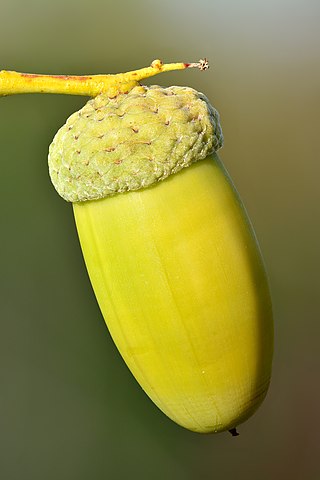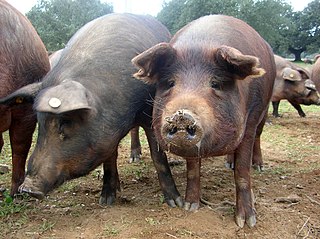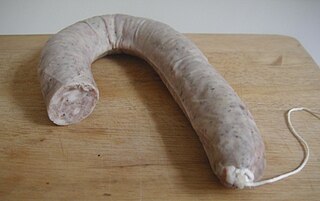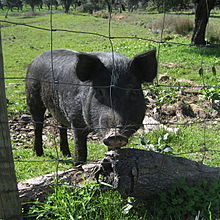
An oak is a hardwood tree or shrub in the genus Quercus of the beech family. They have spirally arranged leaves, often with lobed edges, and a nut called an acorn, borne within a cup. The genus is widely distributed in the Northern Hemisphere; it includes some 500 species, both deciduous and evergreen. Fossil oaks date back to the Middle Eocene. Molecular phylogeny shows that the genus is divided into Old World and New World clades, but many oak species hybridise freely, making the genus's history difficult to resolve.

Quercus ilex, the evergreen oak, holly oak or holm oak is a large evergreen oak native to the Mediterranean region. It is a member of the Ilex section of the genus, with acorns that mature in a single summer.

Quercus suber, commonly called the cork oak, is a medium-sized, evergreen oak tree in the section Quercus sect. Cerris. It is the primary source of cork for wine bottle stoppers and other uses, such as cork flooring and as the cores of cricket balls. It is native to southwest Europe and northwest Africa. In the Mediterranean basin the tree is an ancient species with fossil remnants dating back to the Tertiary period. It can survive for as long as two centuries. Typically, once it reaches 25 years old, its thick bark can be harvested for cork every 9 to 12 years without causing harm to the tree.

The acorn, or oaknut, is the nut of the oaks and their close relatives. It usually contains a seedling surrounded by two cotyledons, enclosed in a tough shell known as the pericarp, and borne in a cup-shaped cupule. Acorns are 1–6 cm long and 0.8–4 cm on the fat side. Acorns take between 5 and 24 months to mature; see the list of Quercus species for details of oak classification, in which acorn morphology and phenology are important factors.

An oak savanna is a type of savanna—or lightly forested grassland—where oaks are the dominant trees. The terms "oakery" or "woodlands" are also used commonly, though the former is more prevalent when referencing the Mediterranean area. These savannas were maintained historically through wildfires set by lightning, humans, grazing, low precipitation, and/or poor soil.

Jamón is a type of dry-cured ham produced in Spain. It is one of the most globally recognized food items of Spanish cuisine. It is also regularly a component of tapas.

Jamón ibérico, known in Portuguese as presunto ibérico, is a variety of jamón or presunto, a type of cured leg of pork produced in Spain and Portugal, in the Iberian Peninsula. It is considered a staple of both Portuguese cuisine and Spanish cuisine.

Quercus faginea, the Portuguese oak, is a species of oak native to the western Mediterranean region in the Iberian Peninsula. Similar trees in the Atlas Mountains of northwest Africa are usually included in this species, or sometimes treated as a distinct species, Quercus tlemcenensis. It occurs in mountains from sea level to 1,900 metres above sea level, and flourishes in a variety of soils and climates. Out of all the oak forests in the Iberian Peninsula, the southern populations of Portuguese oak were found to have the highest diversity and endemism of spider species.

The woodlands of the Iberian Peninsula are distinct ecosystems on the Iberian Peninsula. Although the various regions are each characterized by distinct vegetation, the borders between these regions are not clearly defined, and there are some similarities across the peninsula.

Saucedilla is a municipality located in the province of Cáceres, Extremadura, Spain. It belongs to the Campo Arañuelo County, the capital of which is Navalmoral de la Mata.

Quercus lusitanica, commonly known as gall oak, Lusitanian oak, or dyer's oak, is a species of oak native to Portugal, Spain and Morocco. Quercus lusitanica is the source of commercial nutgalls. These galls are produced by the infection from the insect Cynips gallae tinctoriae. They are used for dyeing.

A dehesa is a multifunctional, agrosylvopastoral system and cultural landscape of southern and central Spain and southern Portugal; in Portugal, it is known as a montado. Its name comes from the Latin defensa (fenced), referring to land that was fenced and usually destined for pasture. Dehesas may be private or communal property. Used primarily for grazing, they produce a variety of products, including non-timber forest products such as wild game, mushrooms, honey, cork, and firewood. They are also used to raise the Spanish fighting bull and the source of jamón ibérico, the Iberian pig. The main tree component is oaks, usually holm and cork. Other oaks, including melojo and quejigo, may be used to form dehesa, the species utilized depending on geographical location and elevation. Dehesa is an anthropogenic system that provides not only a variety of foods, but also wildlife habitat for endangered species such as the Spanish imperial eagle.

The Choctaw Hog is a breed of domestic pig historically used by Native Americans. They are now reduced in population to some hundred animals, most of them in the Choctaw Nation of Oklahoma. The American Livestock Breeds Conservancy calls the Choctaw Hog's status "critically rare" and says it "is a high conservation priority."

Extremadura, Spain is known for its different ways of preparing the Iberian pork and mutton. The main characteristics of the traditional Extremaduran cuisine are its simplicity, its lack of clutter and its low cost. It is also a cuisine reflecting a generous spirit, for many of its preparations used to be cooked in large pots to share with visitors, friends, and neighbors. The resulting dishes are eaten with local bread.

The Ossabaw Island Hog or Ossabaw Island is a breed of pig derived from a population of feral pigs on Ossabaw Island, Georgia, United States. The original Ossabaw hogs are descended from swine released on the island in the 16th century by Spanish explorers. A breeding population has been established on American farms off the island, but they remain a critically endangered variety of pig.

Quercus rotundifolia, the holm oak or ballota oak, is an evergreen oak native to the western Mediterranean region, with the majority on the Iberian Peninsula and minor populations in Northwest Africa. The species was first described by Jean-Baptiste Lamarck in 1785. It is the typical species of the Iberian dehesa or montado, where its sweet-astringent acorns are a source of food for livestock, particularly the Iberian pig. Its acorns have been used for human nourishment since the Neolithic era. It is placed in section Ilex. Some authors described it as a subspecies of Quercus ilex.

Azaruja sausage is a type of sausage from Azaruja, Évora, Alentejo, Portugal. It is listed on the Ark of Taste. They are produced seasonally during the pig harvest season from December until February. Alentejo black pig. Other ingredients include spices and bread. The family recipes go back at least 150 years and the sausages are made in traditional home kitchens using Alentejan fireplaces.

The Southwest Iberian Mediterranean sclerophyllous and mixed forests is a Mediterranean forests, woodlands, and scrub ecoregion in southwestern Europe. It occupies the southwestern Iberian Peninsula, encompassing coastal lowlands and mountains in portions of Portugal and Spain.

The Iberian sclerophyllous and semi-deciduous forests is a Mediterranean forests, woodlands, and scrub ecoregion in southwestern Europe. It occupies the interior valleys and plateaus of the Iberian Peninsula. The ecoregion lies mostly in Spain, and includes some portions of eastern Portugal.






















